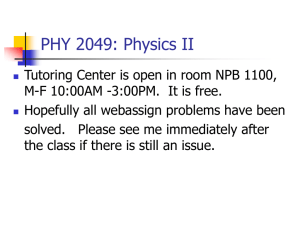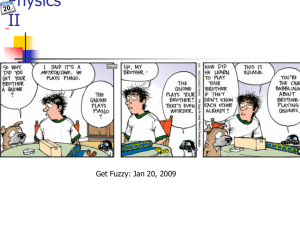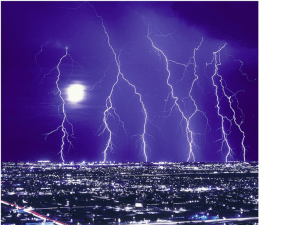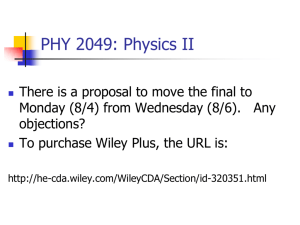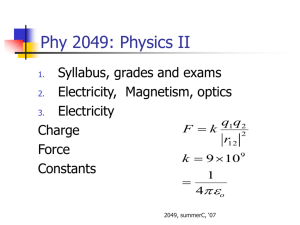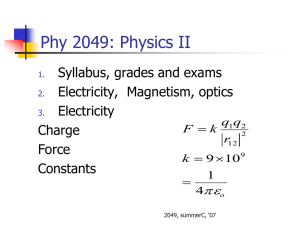Document 10455423
advertisement
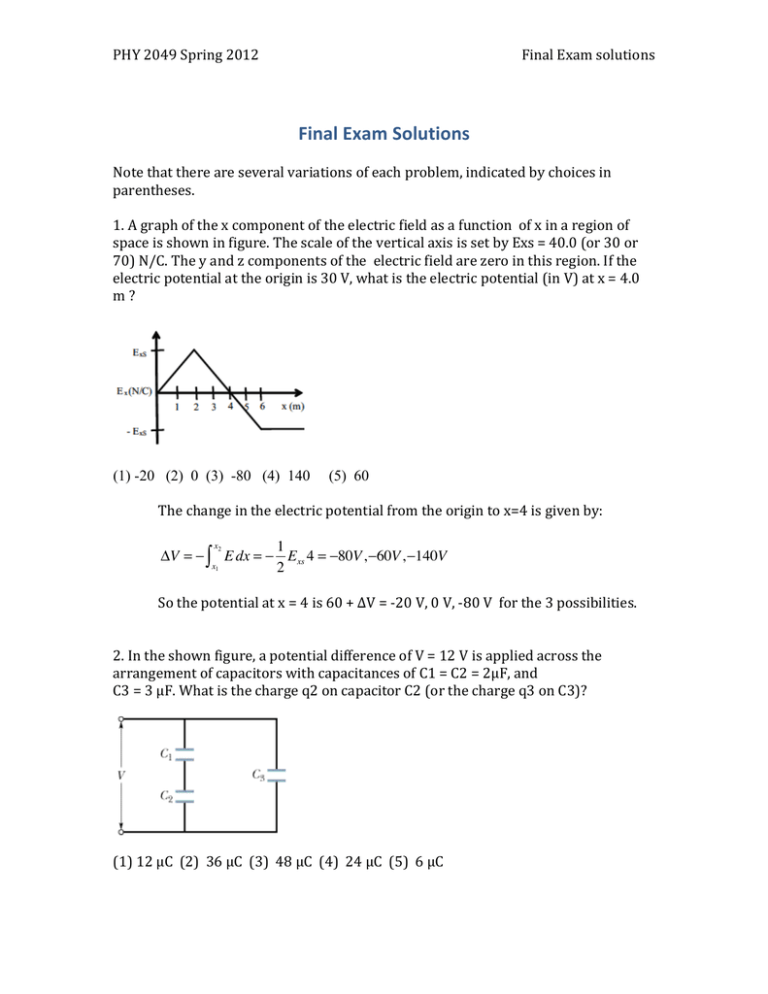
PHY 2049 Spring 2012 Final Exam solutions Final Exam Solutions Note that there are several variations of each problem, indicated by choices in parentheses. 1. A graph of the x component of the electric field as a function of x in a region of space is shown in figure. The scale of the vertical axis is set by Exs = 40.0 (or 30 or 70) N/C. The y and z components of the electric field are zero in this region. If the electric potential at the origin is 30 V, what is the electric potential (in V) at x = 4.0 m ? (1) -20 (2) 0 (3) -80 (4) 140
(5) 60
The change in the electric potential from the origin to x=4 is given by: x2
1
!V = " # E dx = " Exs 4 = "80V,"60V,"140V x1
2
So the potential at x = 4 is 60 + ΔV = -­‐20 V, 0 V, -­‐80 V for the 3 possibilities. 2. In the shown figure, a potential difference of V = 12 V is applied across the arrangement of capacitors with capacitances of C1 = C2 = 2μF, and C3 = 3 μF. What is the charge q2 on capacitor C2 (or the charge q3 on C3)? (1) 12 μC (2) 36 μC (3) 48 μC (4) 24 μC (5) 6 μC PHY 2049 Spring 2012 Final Exam solutions The equivalent capacitance is '1
! 1
1$
Ceq = # + & + C3 = 4 µF " C1 C2 %
The total charge stored on the capacitors is: qtot = CeqV = ( 4 µF ) (12 V) = 48 µC That on C3 is similarly: qtot = CeqV = ( 3µF ) (12 V) = 36 µC So the difference is what is on q2, which is also what is on q1 by the way: q2 = qtot ! q3 = 12 µC Problem 3 Two straight parallel power lines are separated by a distance of 2m. Each carries a current of 5000 A, in the same (or opposite) direction. What is the magnitude of the force per unit length on the wires, and is the force attractive or repulsive? (1) 2.5 N/m, attractive (2) 2.5 N/m, repulsive (3) 5 E-­‐4 N/m, repulsive (4) 5 E-­‐4 N/m, attractive (5) 1.3 E7 N/m, repulsive The force between two wires carrying electric currents is: µii L
FBA = 0 A B
2! d The magnitude of the force per unit length is therefore: 2
4! 10 "7 ( 5000 )
F
=
= 2.5N L
( 2! )( 2 )
To get the sign of the force: • parallel wires with currents in the same direction feel an attractive force. • Wires with currents in the opposite direction feel a repulsive force. (
)
PHY 2049 Spring 2012 Final Exam solutions Problem 4 What is the flux leaving the surface of the shown cube if the electric field is given by !
!
!
E = 2xiˆ ! 3yĵ (or E = 3xiˆ ! 2yĵ or E = 4xiˆ ! 6yĵ ) and the cube has a side length of 2? (a) -­‐8 (b) 8 (c) -­‐16 (d) 16 (e) 0 Because of the directions of the electric field, the flux could only be non-­‐zero for the top-­‐bottom and left-­‐right faces. However, because the field also depends on x and y, the only non-­‐zero contributions are for the top and right faces: ! = ! R + ! T = E R " A R + ET " A T
= (2)(2)(2)2 # (3)(2)(2)2 = #8 or
= (3)(2)(2)2 # (2)(2)(2)2 = 8 or
= (4)(2)(2)2 # (6)(2)(2)2 = #16
Recall that flux is positive when the field points out from a closed surface. Problem 5 In the circuit shown, the ideal batteries have EMFs of ε1 = 9 V and ε2 = 4.5 V and the resistances are R1=30 Ω and R2=15 Ω. If the potential at Q (or instead P) is defined to be 3 V, what is the potential at P (or instead Q)? (1) 10.5 V (2) -­‐4.5 (3) 7.5 V (4) 4.5 V (5) 9 V PHY 2049 Spring 2012 Final Exam solutions First solve for the current in the circuit: !1 " iR2 " ! 2 " iR1 = 0
! "!
4.5
i= 1 2 =
= 0.1
R1 + R2 45
Now let’s add the potential difference to go from point Q to P (or P to Q): VP = VQ + !1 " iR2
VP = 3 + 9 " (0.1)15 = 10.5
or
VQ = VP " ! 2 " iR1
VQ = 3 " 4.5 " (0.1)30 = "4.5
Problem 6 A 50-­‐turn (or 25 turn) circular coil of wire has a diameter of 2m. It is placed with its axis aligned with a magnetic field of 10-­‐4 T. Then the coil is flipped 180° in 0.2s. An average EMF of what magnitude is generated in the coil? (1) 160mV (2) 80mV (3) 3.1mV (4) 1.6mV (5) 31mV Induced EMF is 2
& 2)
$4
2
%10
%
3.14
%
(' +* % ( 50 or 25 )
!" B# r 2 N $ ($B# r 2 N ) 2B# r 2 N
2
E =
=
=
=
= 0.16V or 0.08V !t
!t
!t
0.2
PHY 2049 Spring 2012 Final Exam solutions Problem 7 A glass rod forms a semi-­‐circle of radius r = 7 cm with a charge of +q (or –q) distributed uniformly along the upper quadrant and –q (or +q) distributed along the lower quadrant, where q = 5 pC. What is the magnitude and the direction (as the polar angle relative to the direction of the x -­‐axis) of the electric field at the center P of the semi-­‐circle. (1) 12 N/C, θ= 270° (2) 12 N/C, θ = 90° (3) 0 N/C (4) 18 N/C, θ = 180° (5) 18 N/C, θ = 0° The diagram shows the direction of the electric field contribution from each quadrant. By symmetry, the net field points down in the ! ĵ direction (or î direction), which is ! = 270! (or ! = 90! ) The magnitude (not really needed to choose the correct answer!) is given by: q
!=
"
R
2
dq = ! ds = ! Rd#
"
"
dq
! Rd#
Ey+ q = $ k 2 sin # = $ k
sin #
" /2 R
" /2
R2
!
!
= %k cos# |"" /2 = k
R
R
! 4k q
& Eytot = 2k =
= 12
R " R2
PHY 2049 Spring 2012 Final Exam solutions Problem 8 An electron moves in the î direction, through a uniform magnetic field in the ! ĵ (or ! k̂ ) direction. The magnetic force on the electron is in the direction: (1) k̂ (2) ! ĵ (3) ĵ (4) ! k̂ (5) -­‐i The magnetic force is FB = qv ! B So working with directions only: F = ( !e) î " ! ĵ = k̂ or
F = ( !e) î " ! k̂ = ! ĵ
() ( )
() ( )
Problem 9 Four charges are evenly spaced along the x axis with a separation distance d = 3 cm. The values of the charges are: q1 = +4 μC, q2 = -­‐ 2 μC, q3 = +2 μC, and q4 = +6 μC. What is the net electrostatic force along the x -­‐axis acting on charge q1 due to the other charges? (1) 33 i N (2) -­‐240 i N (3) 130 i N (4) -­‐27 i N (5) 80 i N Carefully work out the magnitude and direction of the force between charge q1 and the others: F1 = F12 + F13 + F14
= +k
q1q2 ˆ
qq
qq
i ! k 1 32 iˆ ! k 1 42 iˆ
2
d
( 2d )
( 3d )
( 9 " 10 )(10 ) # 8 ! 8 ! 24 & iˆ = 33 iˆ N
=
9
( 0.03)2
!12
%$
4
(
9'
PHY 2049 Spring 2012 Final Exam solutions Problem 10 In the figure shown, the ideal batteries have EMFs ε1 = 9.0V and ε2 = 3.0V, and the resistances are each 4Ω What is the magnitude of the current in resistor 3? (1) 1.0A (2) 1.25 (3) 0.25A (4) 0.5A (5) 0A Kirchoff’s junction rule tells us i3 = i1 + i2 Kirchoff’s loop rule for the left loop gives: !1 " i1 R1 " i3 R3 = 0 Kirchoff’s loop rule for the right loop gives: ! 2 " i2 R1 " i3 R3 = 0 Let’s add these two equations: !1 + ! 2 " ( i1 + i2 ) R1 " 2i3 R3 = 0
!1 + ! 2 " i3 R1 " 2i3 R3 = 0
!1 + ! 2 " 3i3 R3 = 0
! +!
9+3
i3 = 1 2 =
= 1.0
3R3
3# 4
PHY 2049 Spring 2012 Final Exam solutions Problem 11 A small spaceship with a mass of only 1.0×103 kg (including an astronaut) is at rest in
outer space with negligible gravitational force acting on it. If the astronaut turns a 10 kW
laser beam, what speed will the ship attain in 1 day because of the momentum carried
away by the beam?
Solution:
The total amount of energy carried away by the laser beam is U = I ! t 1
1
This corresponds to momentum p = !U = ! I ! t c
c
From momentum conservation, the spaceship will acquire the same amount of momentum (pointing away from the direction of the laser beam). The velocity corresponding to this momentum is then: p
1
10 4 J !(24 ! 60 ! 60s)
v= =
! I !t = 3
= 0.00288 m / s
m mc
10 kg !3 "108 m / s
Problem 12 A parallel plate capacitor has circular plates of radius R and plate separation d. The potential difference between the plates is given by the time dependent function. What is the maximum value of the magnetic field induced between the plates at a radial distance 2R from the axis of symmetry? Solution:
V E
= sin(2! f t) d d
The flux of the filed through the circle of radius 2R (note: outside of radius R, there E (! R 2 )
sin(2! f t) is no field): ! E = E(! R 2 ) =
d
! ! 1 d# E
1 E (! R 2 )
(2! f )cos(2! f t) , Then, we can use " B ! ds = 2
: B ! 2! (2R) = 2
c
d
c dt
1 E ! Rf
From where the amplitude of the magnetic field is B = 2
c 2d
The electric field between the capacitor plates at any given time is E =
PHY 2049 Spring 2012 Final Exam solutions Problem 13 An oscillating current in an inductor-capacitor LC-circuit emits electromagnetic waves
with a wavelength λ. What is this wavelength, if L=0.25 µH and C=25 pF?
Solution:
The frequency of oscillation in LC-circuit is f =
The wavelength is then ! = c / f =
1
2"
1
2!
1
LC
1
= 2" LC ! c = 4.71 m LC
Problem 14 Initially unpolarized light is sent along the z-axis into a system of three polarizing sheets
placed perpendicular to the z-axis and whose polarizing angles with respect to y-axis are
30º (first sheet on the way of light), 90º (second sheet on the way of light), and 45º (the
last sheet). What percentage of the initial light intensity is transmitted by the system?
Solution:
Fraction of unpolarized light transmitted by the first polarizing sheet is ½. The transmitted light is now polarized. The second polarizing sheet is rotated with respect to this light by 90º -­‐ 30º = 60º. The fraction of light transmitted is the second
polarizing sheet is cos2(60º) = ¼
The light is again polarized and the plain of polarization is now at 90º. The third
polarizing sheet is rotated by 45º with respect to the plain of polarization of the incoming
light. The fraction of light transmitted is the third polarizing sheet is cos2(45º) = ½.
The final fraction of the light intensity that makes through all three polarizing sheets is
1 1 1 1
then ! ! =
" 6% 2 4 2 16
PHY 2049 Spring 2012 Final Exam solutions Problem 15 A ray of light enters a glass cube from air at point A at an incident angle of θ=30o and then undergoes total internal reflection at point B. What the minimum value of index of refraction n of glass can be inferred from this information? (a) 1.12 (b) 1.22 (c) 1.32 (d) 1.39 (e) 1.41 Solution:
By Snell’s law, the refracted light at point A will have an angle θR with respect the
normal to the cube side surface such that sinθ = n ⋅ sinθ R, or sinθ R= sinθ / n The refracted ray will make an incident angle with respect the top surface (90º-θR). For
the full reflection:
sin(90º-θR) ≥ 1/n, from where: cosθR ≥ 1/n
By squaring and adding the two equations one obtains (remember that sin2θ R+cos2θ R=1):
sin 2 ! 1
1! 2 + 2
n
n
n ! 1 + sin 2 ! = 1 + sin 2 30° = 1.25 = 1.12
PHY 2049 Spring 2012 Final Exam solutions Problem 16 Two identical converging lenses with a focal distance of f=8 cm are separated by a
distance 16 cm. An object of 1-cm size is placed 4 cm in front of the two-lens package.
What is the absolute size of the image formed by the two lenses?
Solution:
The first lens makes an image at the distance i1 = -8 cm, which we find from
1 1 1
+ = . p1 i1 f
This image is virtual, i.e. it is in front of the first lens. The image is magnified by m1 = |i1/p1| = 2 times. The image of the first lens is the object for the second lens at a distance p2=16 cm away from it. The image produced by second lens then appears at distance i2 = 8 cm,
which we find from
1 1 1
+ = .
p2 i2 f
The magnification produced by the second lens is m2 = |i2/p2| = 0.5. The final magnification is m= m1 ⋅ m2 = 2 ⋅ 0.5 =1. Therefor, the final image is of the same size as the original object, i.e. 1 cm. PHY 2049 Spring 2012 Final Exam solutions Problem 17 An object is placed 3.6 cm in front of a concave/convex mirror. Its image is virtual and
four times tall as the object. Find the focal length of the mirror.
(a) 4.8 cm (b) -­‐4.8 cm (c) 2.4 cm (d) -­‐2.4 cm (e) 1.6 cm Solution:
1 1 1
+ =
p i f
The image is virtual (i is then negative) and four times larger than the object (|i/p|=4).
1 1
1
4
= . From here, f = p = 4.8 cm Therefore, !
p 4p f
3
Problem 18 Two coherent radio-­‐frequency point sources separated by d=4 m radiate in phase with a wavelength λ=1 m. A detector moves in a circular path of some radius R around the mid-­‐point between the two sources (see figure) and measures the radio-­‐wave intensity of the signal. Find how many maxima it detects. Solution:
!L
= 2" " 4 #
!L
The phase difference between two sources at the top point is !! = 2"
= 2" "(#4) #
The phase difference between two sources at leftmost and rightmost top points !! = 0 = 2" "(0) The condition for the maxima points is !! = 2" " m , where m is any integer number. As a detector moves along the circle, the phase difference changes from !! = 2" "(#4) to !! = 2" " 4 . Hence, if one starts at the bottom, m changes from -­‐4 (bottom) to 4 (top) and back to -­‐4 (bottom). The number of integers in this sequences is 16: -­‐4, -­‐3, -­‐2, -­‐1, 0, 1, 2, 3, 4, 3, 2, 1, 0, -­‐1, -­‐2, -­‐3, -­‐4. Hence, the number of maxima occurring along the circle is 16. The phase difference between two sources at the top point is !! = 2"
PHY 2049 Spring 2012 Final Exam solutions Problem 19 We wish to coat a glass lens (n=1.50) with a transparent material (n=1.25) so that the reflection of light at wavelength 600 nm (in air) is eliminated by interference. What minimum thickness can the coating have to do this? Solution:
The ray that bounces off the coating acquires !1 = " (reflection from a higher-­‐index-­‐
of-­‐refraction material). The ray that goes into the coating material, bounces off glass surface, and then goes h
h
back through the coating acquires ! 2 = 2"
+ " + 2" , #n
#n
!
where !n = is the wavelength of light inside the material of coating (n=1.25). n
To eliminate reflection, the interference between the two ray must be destructive, i.e. !! = ! 2 " !1 = " + 2" m !
h
h$
Hence, # 2!
+ ! + 2! & ' ! = ! + 2! m , from where "n %
" "n
1 + 2m
1 + 2m !
h=
!n =
4
4 n
!
hmin =
= 120 nm
4n
Problem 20 What is the smallest object on the Moon that can be resolved with the Hubble Space Telescope whose diameter is 2.4 m? The typical light wavelength is 500 nm. The distance between the Earth and the Moon is 400,000 km. Neglect the fact that the telescope is at 600 km above the Earth. Solution: Telescope angular resolution due to the diffraction of light on the aperture of the mirror is 1.22⋅λ/D, where D is the mirror diameter. An object of size h at distance d has an angular size h/d. From making the two equal, h/d = 1.22 ⋅ λ/D, one finds h = 1.22 ⋅ λ/D ⋅ d = 102 m
